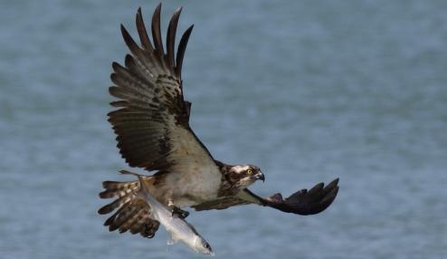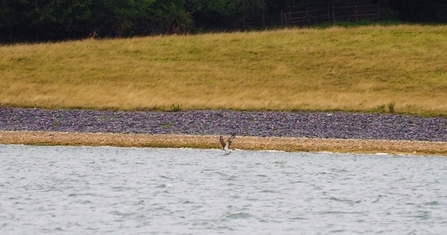
Rutland Osprey fishing in Senegal - John Wright (http://wrightswanderings.blogspot.co.uk/)
Join by 30 January to get 3 months free membership!
Rutland Osprey fishing in Senegal - John Wright (http://wrightswanderings.blogspot.co.uk/)

Rutland Osprey fishing in Senegal - John Wright (http://wrightswanderings.blogspot.co.uk/)
Two weeks ago, I was lucky enough to be included in a staff trip to Rutland Water to observe and learn about their osprey project. To their great pride, they had the first breeding ospreys in England in 2001 (only beating Bassenthwaite by 2 days). This was possible because of their osprey translocation project.
They identified Scottish birds that were genetically similar to the birds historically found in England. The Scottish population was chosen over a continental European population because the translocation would be far less traumatising for the young chicks over a shorter distance. The chicks were 6 weeks old when they were chosen to be translocated – usually from larger broods (that being two or three chicks). The general idea was to convince the osprey chicks they were born in Rutland, in order to increase the likelihood of them returning to breed there in future years. This was successful in 2001, and since then they have had many more ospreys breeding on their reserve.
The Rutland Osprey team have even developed links with locals in The Gambia and Senegal – and through these connections have organised trips to the West-African nations in order to find and study their local ospreys.
Whilst at Rutland, our team was guided around the reserve, being talked through the long and arduous process of going from an operation of a similar size as our Foulshaw Moss project – to a point where they can hire people in Western-Africa to assist in their osprey project.
After our guided tour of the reserve, we were taken on an “osprey cruise” where we got to see 6 different individuals fishing (and of course my camera battery died just before some spectacularly close fishing). Fortunately, I did get some pictures of one of their male birds bringing up a very large trout, so I didn’t come away empty handed!

James Barclay. Osprey diving at Rutland Water
Anyway, enough about Rutland - especially since our ospreys have been so active of late. We can’t say for sure, but only three birds have been seen on the site since last week. It is fairly normal for the female to leave first, so Blue 35 will probably be winging back to West-Africa as you read this. It also seems that White WY has started to make his way back as well. We think this because the birds remaining on the site seem to be the chicks (based on their unusual perch trees and slight variations in their plumage. It’s unusual for the male to leave before the chicks, and he normally stays until the chicks are ready to set off and can fend for themselves. This seems to be the case however since yesterday I captured footage of one of the chicks feeding on a successful catch – which you can see below.
Ospreys Feeding at Foulshaw Moss 2017. Cumbria Wildlife Trust
I’m sorry for the delay in this update, between our Rutland trip and work with Foulshaw, I’ve been swamped. To compensate, my next update will contain all of my wildlife photography from down at Foulshaw (Ospreys included) since that will likely be my last post relating to our ospreys. In all likelihood, they might be back in Africa by then, but not quite to The Gambia.
See you in a fortnight!
James
About the author
James is a student placement gaining experience in wildlife conservation alongside Foulshaw Moss Nature Reserve Officer, Paul Waterhouse.